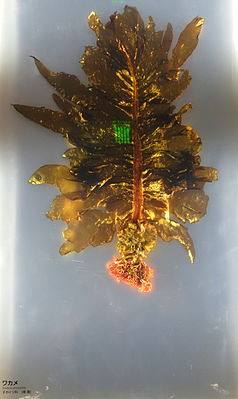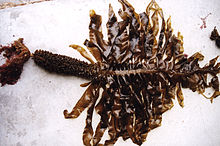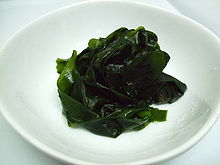Undaria pinnatifida
| Undaria pinnatifida | ||||||||||||
|---|---|---|---|---|---|---|---|---|---|---|---|---|

Undaria pinnatifida |
||||||||||||
| Systematics | ||||||||||||
|
||||||||||||
| Scientific name | ||||||||||||
| Undaria pinnatifida | ||||||||||||
| ( Harvey ) Suringar |
Undaria pinnatifida , also called wakame in Japan, is a marine brown algae from the order of the Laminariales . It is valued as food in Japan and Korea. Originally native to the coasts of East Asia, it is now widespread as an introduced and invasive species in many seas.
description
The sporophyte of Undaria pinnatifida is a large yellowish to brown seaweed with a thallus one to two (rarely three) meters in length. It is attached to the ground with a root-like adhesive organ ( rhizoid ), which is forked and claw-like. The oar-shaped, stem-like cauloid is flattened and has an irregular edge that is reminiscent of a fried egg. It spring from small growths and limp in the lower part two, with maturity frill-like wavy Sporophylle . The upper part of the cauloid continues in the leaf-like phylloid as a flattened, 1–3 cm wide central rib. The more or less pyramidal phylloid is divided into numerous broad leaf lobes 50–80 cm long.
In summer the spores are released. They are spread, establish themselves and germinate into microscopic gametophytes , on which the sperm and egg cells mature in late winter at a suitable temperature, light intensity and water depth. The fertilized egg cell grows back into a large seaweed.
Occurrence and invasive behavior
Undaria pinnatifida is native to the cold, temperate sea coasts of the West Pacific ( China , Japan and Korea ). It was probably introduced on the coasts of New Zealand , Tasmania and Argentina by fishing fleets from Southeast Asia . After it was introduced for commercial use in Brittany , it has now spread widely as an invasive species in the Northeast Atlantic (south coast of England , France , Spain ) and the Mediterranean .
Undaria pinnatifida grows in the lower intertidal zone and in the area a few meters below the low water line . It prefers sheltered places and is often found in marinas, on buoys or floating harbor structures. In Venice it overgrows the lower steps to St. Mark's Square and the anchor chains of the stops for water traffic.
Undaria pinnatifida colonizes new substrates very quickly and forms a dense, annual kelp forest . Due to their abundant growth, for example on fish cages or mussel cultures, Undaria pinnatifida can become an annoying problem for marine farms. It can also displace native species. Therefore it was placed on the list of the 100 most dangerous neobiota . The species does not currently exist on the German coast, but in 2013 it was placed on the "Warning list of invasive animals and plants not yet found in Germany".
Systematics
It was first described in 1860 by William Henry Harvey as Alaria pinnatifida . Willem Frederik Reinier Suringar placed the species in the genus Undaria , of which it is a type species . Another synonym is Ulopteryx pinnatifida (Harvey) Kjellman.
use
In Japan, Korea and China, Undaria pinnatifida is of considerable economic importance as an algae food . In Japan it is known as “Wakame” ( Japanese 若 布 , 和 布 or ワ カ メ ), in Korea as “miyeok” ( Kor. 미역 ), and in China as “Qundaicai” ( Chinese 裙带 菜 ).
In Japan, wakame is more important than the laminaria species; Undaria pinnatifida has been cultivated there since the Nara period . In the past, to increase production in wild stocks, additional stones were introduced or rocks were smashed to enlarge the colonizable surface. Between 1960 and 1969, 40,000–60,000 t fresh weight could be harvested from natural stocks annually . Since the early 1960s, the alga has been cultivated on long ropes that are covered with the sporophylls. In 1976 the yields were around 20,000 t fresh weight from wild stocks and 127,000 t from crops. The harvested algae are washed and marketed in a dried state.
In Japanese cuisine, wakame is often used as an ingredient in soups, for example miso soup, which gives it a stronger flavor. Wakame is also roasted ( Yaki-wakame ), semi-moist with rice, or prepared with a sugar coating ( Ito-wakame ). As a salad with sesame ( goma-wakame ), it is also popular with sushi outside of Japan . Wakame salad made from boiled, finely chopped wakame with a little sesame oil, chili and sesame seeds is also known as chuka wakame and is usually sold frozen.
In Korean cuisine , this alga is used for soups, porridges and salads. The salads come in a wide variety of forms and preparations - sesame is often used to refine it.
In China, Undaria pinnatifida is less popular than the Laminaria species and is used to a lesser extent.
In Brittany, too, the alga was at times successfully cultivated on ropes.
ingredients
Wakame contains iodine (10–20 mg / 100 g dry substance iodine), and it also contains alginic acid .
The ingredient Fucoidan could have preventive effects against cancer. The fucoxanthin from wakame caused increased fat burning in mice.
swell
- ↑ a b c d e Michael Guiry: The Seaweed Site: information on marine algae: Undaria pinnatifida , accessed May 27, 2014.
- ↑ a b c Undaria pinnatifida. Global Invasive Species Database, accessed May 28, 2014 .
- ↑ Wolfgang Rabitsch, Stephan Gollasch, Maike Isermann, Uwe Starfinger Stefan Nehring: Creation of a warning list of invasive animals and plants not yet occurring in Germany. In: BfN-Skripten 331.Bundesamt für Naturschutz, 2013, p. 34 , accessed on May 28, 2014 .
- ↑ M. Isermann, S. Nehring: Nature Conservation Invasiveness Assessment Undaria pinnatifida - Wakame ; created on January 15, 2013. - Federal Agency for Nature Conservation, Bonn: 2 pages, accessed May 29, 2014
- ↑ Michael D. Guiry, GM Guiry: Undaria pinnatifida - In: Algaebase - World-wide electronic publication, National University of Ireland, Galway, accessed May 27, 2014
- ↑ Ole G. Mouritsen, Prannie Rhatigan, José Lucas Pérez-Lloréns: World cuisine of seaweeds: Science meets gastronomy . In: International Journal of Gastronomy and Food Science . tape 14 , 2018, p. 57 , doi : 10.1016 / j.ijgfs.2018.09.002 (English).
- ↑ a b c Michael Guiry: The Seaweed Site: information on marine algae: Seaweed as Human Food , accessed May 27, 2014.
- ↑ Ole G. Mouritsen, Prannie Rhatigan, José Lucas Pérez-Lloréns: World cuisine of seaweeds: Science meets gastronomy . In: International Journal of Gastronomy and Food Science . tape 14 , 2018, p. 57 , doi : 10.1016 / j.ijgfs.2018.09.002 (English).
- ↑ a b Nori, Wakame and Kombu: The algae kitchen for gourmets. Bio Topics, accessed on May 27, 2014 .




